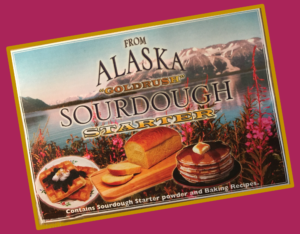For some time now I have wanted to make rye bread, but that means converting my sourdough starter from a wheat starter to a rye start.

A powdered starter made by Alaskan Wild Teas and Cocoa
Luckily my brother returned from an Alaskan cruise with this gift; a Sourdough Goldrush Greeting Envelope. He knows I bake artisan bread and has received several of my Sourdough Saturday trial loaves, (maybe he wants more).
So rather than toss this into my collection of dried starts I have been keeping in food storage, I decided to make it a rye starter. My curiosity has been driving me to know if it tasted any different than my Abigail’s Oven start.
But if I activated this, I knew I would soon be caring for “twins.” By caring I mean feeding, watching over, using, and storing two unique starts. I hope to be up to it—instructions with the envelope suggested I combine
- 2 cups of flour
- 2 cups of water
- dry culture starter
Their instructions also explained:
“Use a wooden or plastic spoon to stir the mixture until smooth. (Metal does not work.) Cover the container with plastic wrap and a towel and place in a warm area for 36 to 48 hours. Gently stir several times a day. Your starter should give a slightly yeasty aroma. Cover your container (after two days) and let it rest in the refrigerator. To use your starter simply remove the amount called for in the recipe and add to the other ingredients.”
Okay, I did all that, but after 72 hours not much was going on so I added 1/3 cup whole-wheat flour and 1/4 cup water, just like Martha Levie had trained me to do. Wow! That jar filled with a sponge right away.

I keep active starters in separate Ball Pour & Measure capped wide-mouth quart jars and store them in the fridge and back-ups in the freezer.
Happily, since then, I have just added rye flour and have a good starter going now and I will be making rye bread soon.
Conclusion
That little envelope stated:
|
“Sourdough is thought to be the oldest form of leavened bread. Prospectors in the Klondike gold rush in Alaska brought it with them as treasured family heirlooms and passed them from generation to generation. Start your own heirloom or send to friends or family as a unique gift.
|
I have succeeded with both Mischbrot and Marbled Rye and now I am the proud owner of both a San Francisco and Yukon Sourdough start. Personally, I cannot tell a taste difference. Let us know how you make Roggenbrot, Graubrot, Mischbrot, or anything else you call rye bread.
Author: Darryl Alder, retired Scouter and outdoorsman, who spent too many hours over a campfire using a dutch oven, and loves sharing recipes for the kitchen and the campfire.


